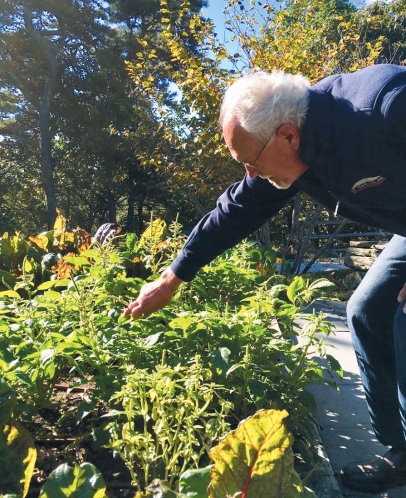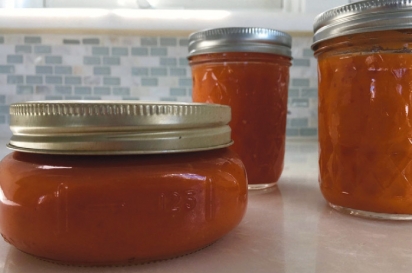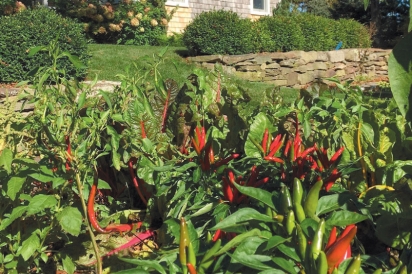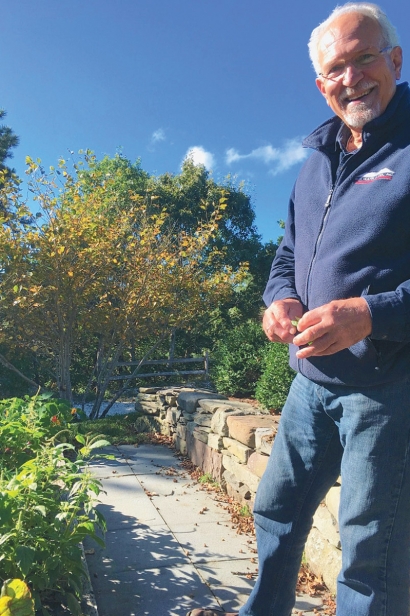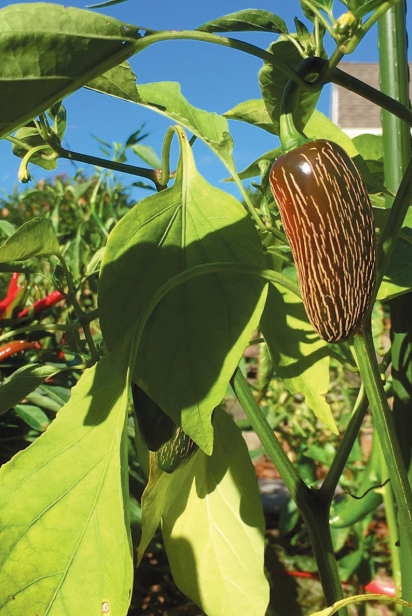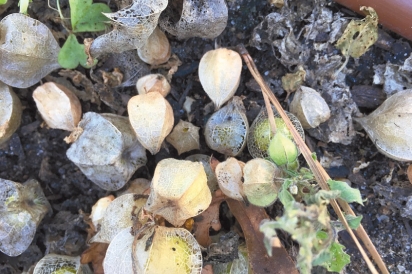Some Like it Hotter
During a summer stroll on the outer beach, I bumped into my old friend Adrian who was camped out with his family for the night. He showed my husband and me his camper and grill and described the fish he planned to prepare topped off with the best hot sauce in the world, that just happens to be made by his father-in-law, affectionately known as Grampa Art. He said Art loves gardening and all things food; he grows his own peppers and brews the stuff in big pots in the kitchen of his home on the Outer Cape. “Whatever is abundant in his garden is what ends up in a batch of hot sauce,” says Adrian. “He even mixes watermelon into it.” Watermelon? This, I’ve gotta see. Or… taste.
So on a brisk day in October, I drove to Art’s home, hidden at the end of a long, winding driveway in the hills of North Truro, which is also his place of business. Art is the owner of A.F. Hultin & Co. Inc., a construction company specializing in custom homes and sustainable living. Art’s own house, built on a hilltop surrounded by trees, and on the day of my visit, topped by big, blue sky, is a clean-cut but comfortable and welcoming hideaway. Crisp and classic Cape Cod design is softened by loping hydrangeas, meandering stone pathways, and his pride and joy: two hillside gardens.
Art speaks thoughtfully and smiles easily. Walking through the gardens with him is like shadowing a painter examining his plein air palette. Varying heights, colors and shapes reveal tidy and abundant rows of chard, beets, onions and, of course, peppers. No bell peppers, though. Art is not fond of them. He plucks, tastes and trims, and proudly points to habaneros, jalepeños and el hombres and explains their properties; they do surprisingly well during the cool temperatures of autumn, says Art. Some are as bright as rubies, but others I can’t even see—many are still green and blend in with their verdant foliage. Art kneels and gently lifts a branch at the base of a habanero plant to reveal bright orange pepper babies hidden beneath, ripening from the bottom up.
The second garden is mostly picked over, save for some Bibb lettuce and a gangly tangle that appears at first to be some sort of seed pod so paper thin it’s a wonder they haven’t blown away in the wind. But then Art picks a pod dangling from a curling, cracking stem and beckons me to take a closer look. Inside one of the tiny crepe-papery packets is a bright green berry. He plucks it and pops it into his mouth.
“Here, try one,” he insists. Given Art’s fondness for heat, I’m reluctant and he chuckles when I ask if it’s hot. To my surprise, the flavor of this tiny green gem leaves me equal parts puzzled and immensely pleased. Art calls them ground tomatoes—“goldies”—and tells me they are related to tomatillos. We pop them into our mouths one at a time, and decide they’re too special to drown in a jar of hot sauce. Oh yeah, back to the hot sauce…
Art got into making it when one of his customers left her summer house at the end of the season, also abandoning her raised bed gardens. Before she left, she told Art he could have at it. “Right there were all the fixings for a great harvest: habaneros, Thai peppers, eggplant, onions and herbs,” says Art. “I could not resist harvesting them to avoid losing them to frost.” He looked online for hot sauce inspiration and went for it. “People tell me all the time I should sell the stuff,” he tells me. But he’s reluctant to do that; he likes giving it away to his family and friends. “It turned into something everyone liked and every time I make a batch, it’s gone quickly,” he says. Plus, breaking into the hot sauce business would require a standardized recipe and for now, Art is having too much fun experimenting to be pinned down to a recipe, he improvises every single time. However, he did share what he calls his “basic formula” with me.
First, habaneros. Lots of them. If Art is in the mood to make hot sauce and his peppers aren’t ripe yet, he buys some fresh at Stop & Shop. “They are about $3.50 a pound, which seems like a lot, but if you figure there’s about 50 to 60 peppers in a pound, depending on plumpness, and if there’s about two habaneros per jar, it’s no big deal.”
He softens garlic cloves, an onion or two and some shallots in one to two tablespoons of oil in a large pot. Next, he de-stems the peppers, leaving the seeds in—that’s where the heat is—and tosses them in. “And that’s when I open a window or two and turn on the vent fan, otherwise it can get pretty steamy in here,” he says with a smile, feigning a sweaty brow. He lets that cook for about ten minutes, then lets it cool before adding the mixture to a blender with white vinegar, some salt, maybe a pinch of sugar and whatever he chooses to “thin” it with.
The fresh flavor of Art’s sauce comes from the bounty abundant in his organically grown garden. Everything is fair game: cucumbers, zucchini, carrots, watermelon… he has even used the white flesh of eggplant. (He hasn’t yet tried beets though. He’s going to give that a go and get back to me.) It all gets tossed into the blender and he keeps adding until he has made “about two blenders full” which we decide is approximately 16 cups. He saves it in assorted half-pint jars and doesn’t bother steam-canning it. “It doesn’t last that long,” he says with a grin. Another impediment to coming up with a singular tried-and-true recipe: tasting hot sauce as he concocts it is difficult. One or two nibbles of a batch-in-process blows his taste buds too much to be able to discern what each batch needs. So when he opens a jar days later, the flavor is a surprise to him, too.
On the day of my visit, Art has three jars left from his most recent hot sauce-making session; the contents are brilliant, sunshine orange in color. He is eager for me to have a taste and I’m wishing my husband were here with me—his tolerance for heat eclipses mine by a mile. Actually, everyone’s tolerance for spicy food surpasses mine. Art opens a jar and grabs a bag of chips from the pantry. He dips the corner of a chip into one of the jars, chews while looking up and into the distance. He’s thinking. In the meantime, I wonder aloud what the three Xs on the lid are for. “Oh, that’s because we couldn’t come up with a name for hot sauce with ghost peppers. It’s like, a danger sign.” Ghost peppers? Yep, ghost peppers—only one of the hottest peppers on the whole darn planet. Lucky me. Art is dipping and eating and I’m recalling a factoid from the Guinness World Record, something about ghost peppers being hundreds of times hotter than Tabasco, which for Art is probably child’s play and for me is insufferable. After a moment, he decides that a taste is too hot for me. Stay away from the triple-X hot sauce too fiery for words? I’m in fervent agreement.
Jar number two, same process. He dips, he eats, he ponders. Yes, this one’s better, he says. I should try it. “But just a little,” he warns me, as if I need encouragement to take it easy. He demonstrates how to dip only the little corner of the chip into the sauce to retrieve about a drop. I follow his instructions and take a bite. The first thing I notice—cool, fresh carrot flavor, times ten. Next, a pleasant kick of vinegar and surprising brightness. The heat doesn’t hit me right away, and I immediately want to scoop a more substantial sample. Art must have read my mind. “Wait,” he tells me. A few moments later, the back of my throat gets warm. The feeling grows and intensifies for a few moments afterward, but it isn’t overwhelming or unpleasant. Still, it’s a lot for me. I wish I could dig in and eat more because just that littlest bit was such a delight, like tasting springtime.
Art attributes his hot sauce success to two things. First, he credits organic compost for nourishing his garden and taking the quality of his produce to new levels. He gets it from son Adrian, who is knowledgeable in his own right about all things botanical. He is the owner of Harrow & Seed, a landscape company, which, like Art, also specializes in sustainable design. Living in sync with the land runs in the family. And second, Art isn’t afraid to experiment. As we compare notes about our favorite eateries on the Cape, Art says he prefers to cook at home. “I don’t do anything fancy, but my family tells me some of the best meals they have are right here,” waving his hand over his large, marble-topped kitchen island and pausing to emphasize his point with one more dip into a jar of hot sauce. Art continues nibbling as we talk, and then smiles and mops his brow for real.


